The photo below, of pizza at a cafe, appeared on my previous post. It was taken with a polarizing filter on the lens adjusted to block glare from the window in the background. Mouseover the “Without Polarizer” button below for the same scene two seconds later, without the filter...

Nikon D200 + Nikkor 17-55 f/2.8 @ 24 mm — 1/90 sec, f/2.8, ISO 500 — map & image data — nearby photos

Nikon D200 + Nikkor 17-55 f/2.8 @ 24 mm — 1/125 sec, f/2.8, ISO 500 — map & image data — nearby photos
mouseover button to see that image
The difference is striking.
Without the filter, the reflections on the pizzas, table, and glasses of water just destroy the scene. I'm glad I happened to have brought the my polarization filter that day. In the “Without Polarizer” picture, the filter is still actually on the lens, but rotated so that it doesn't comb out the reflections.
Normally, the individual waves that make up light are not “oriented” in any particular direction, so a filter designed to comb out light waves having a particular orientation doesn't do much except dim the whole scene a bit (because it removes the few percent of waves that happen to have that orientation). However, in some situations, all the waves of a particular light find themselves oriented at the same angle – it's polarized light – so filtering for that angle stops all that light, while only slightly dimming the rest of the light.
In the scene above, the background glare reflected from the pizzas, table, and water glasses was polarized, so I simply rotated the filter in front of the lens until the reflections dimmed... they dimmed because the angle of the filter “comb” matched the orientation of the waves making up the glare, thereby blocking it.
This next example (from our trip to Kanazawa) shows that the filter blocked almost all the reflection of the sky, but left the locally-lighted reflection of the water glass...
Wikipedia has a detailed discussion of the physics of polarization, but for practical photographic applications, Light — Science and Magic is excellent.
It's not always easy to predict what light will be polarized when, or to what extent, but modern polarization filters can be freely rotated while affixed to the lens, so it's a simple matter of rotating the lens a bit to see what, if any, light is attenuated. When there's a lot of polarized light, a polarization filter adds additional ways to be creative. Consider a close-up of yesterday's pizza...

Nikon D200 + Nikkor 17-55 f/2.8 @ 45 mm — 1/60 sec, f/2.8, ISO 500 — map & image data — nearby photos

Nikon D200 + Nikkor 17-55 f/2.8 @ 45 mm — 1/30 sec, f/2.8, ISO 500 — map & image data — nearby photos
Without the filter, the glare just destroys the picture, but with the filter at full effect, the pizza looks dull and lifeless. Well, it's a pizza, so it is lifeless, but it need not be dull, so if I had been serious about making a portrait of the pizza instead of eating it, I'd likely have tried rotating the filter such that a touch of glare was left to enhance the 3-D look of the surface.
In this wider shot, though, where the pizza is not the whole image, I'm happy to forego sparkle in the pizza in order to reveal the richness of the table's wood grain... richness that without the filter the glare blows away.

Nikon D200 + Nikkor 17-55 f/2.8 @ 34 mm — 1/100 sec, f/2.8, ISO 500 — map & image data — nearby photos

Nikon D200 + Nikkor 17-55 f/2.8 @ 34 mm — 1/160 sec, f/2.8, ISO 500 — map & image data — nearby photos
It's less clear to me what to do with the salad...

Nikon D200 + Nikkor 17-55 f/2.8 @ 48 mm — 1/80 sec, f/2.8, ISO 640 — map & image data — nearby photos

Nikon D200 + Nikkor 17-55 f/2.8 @ 48 mm — 1/60 sec, f/2.8, ISO 640 — map & image data — nearby photos
I was just playing around with the filter prior to more important tasks (eating), so I didn't notice that the focus point slipped between the two pictures, and that focus difference has a greater effect on the overall feel than the glare or lack thereof.
Reflections aren't always a bad thing. The polarization filter pretty much destroys the shot below, from our trip to the Heian Shrine during a rare snowfall....
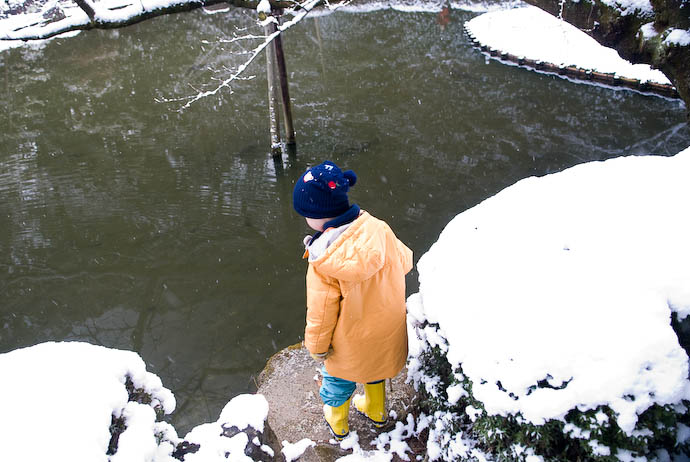
Nikon D200 + Nikkor 17-55 f/2.8 @ 17 mm — 1/80 sec, f/2.8, ISO 400 — map & image data — nearby photos
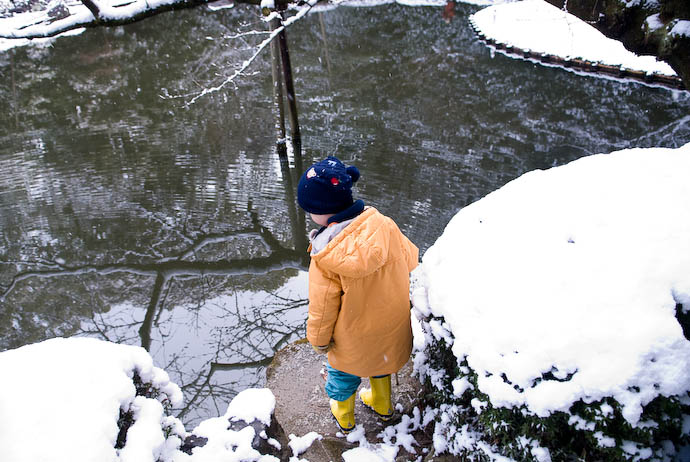
Nikon D200 + Nikkor 17-55 f/2.8 @ 17 mm — 1/125 sec, f/2.8, ISO 400 — map & image data — nearby photos
Well, okay, it was my composition that destroyed these shots because both are pretty pathetic, but you can see how much more interesting a well-composed shot would be with the reflections of the snowy branches left in tact.
Some things, like Plexiglas, or glass under stress, polarize light passing through in sort of random ways that can reveal internal stresses – useful for scientific and safety applications – but which make a polarizer fairly useless. Here's a scene from the Geometric Richness in Kanazawa Station that shows unsightly patterns regardless of the angle the polarization filter is rotated to...
In these cases, you do have to physically remove the filter from the lens in order to avoid the patterns, because they appear to some extent at all rotations of the filter.
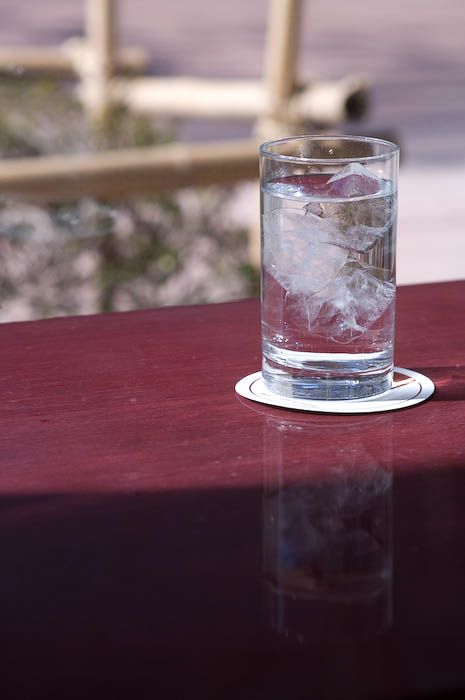
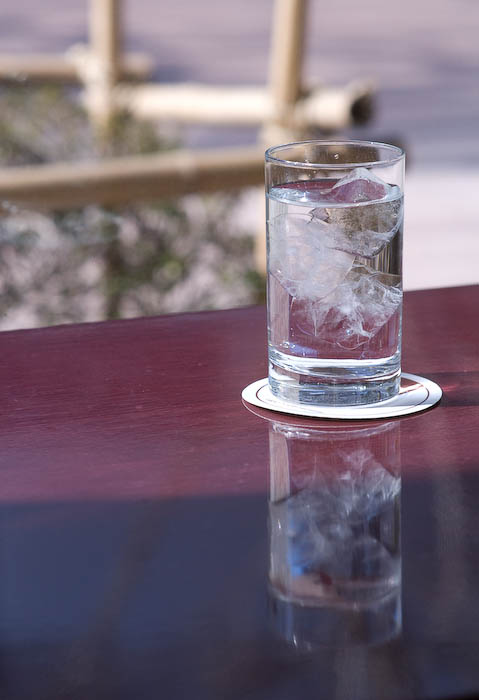
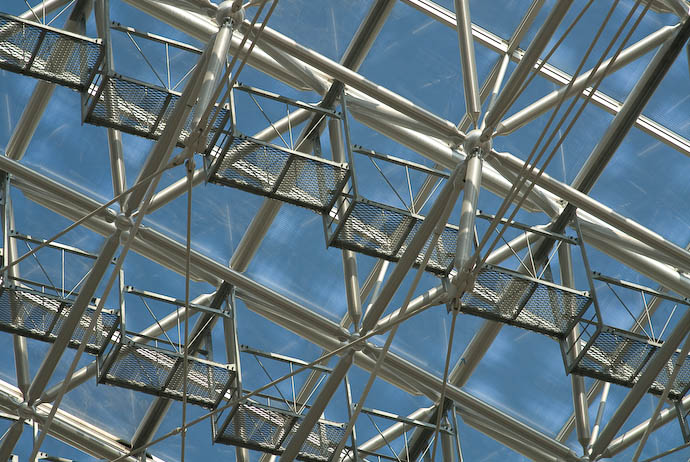
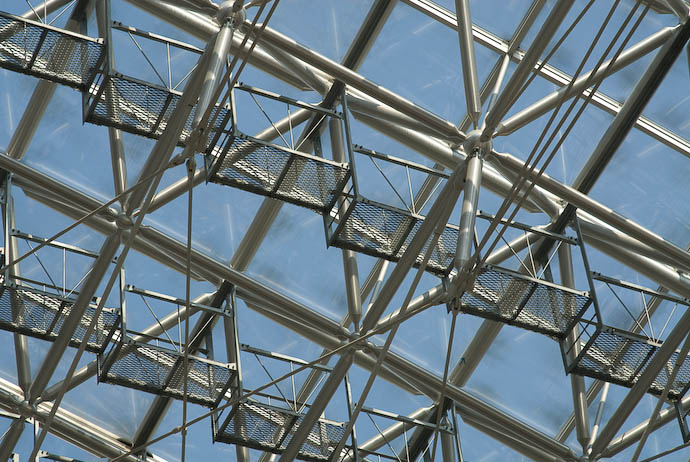
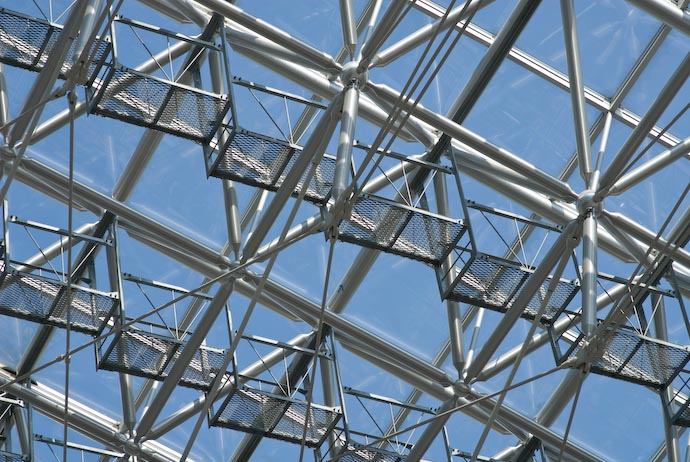
This is an amazing post. I thought I understood polarizers, but I learned a lot today.
My Bro-in-law sent this post. Great examples. I also have to say the pizza looks amazing! The tables and glasses…also amazing! I wish I was back in Japan right now, so I could find that place and eat some pizza!
Hey, enough with the closeups of that food. It causes great distress to those of us trying to diet. Stick with the snow and roof structures..things like that. Had to get after your brother-in-law Marty who inflicted the same kind of pain with closeups of his BBQ ribs. If he does it again, he’s out of the will. BTW, when you come to the states next month, you ARE bringing some of those great flaky Japanese cookies, aren’t you?? Don’t forget, now. Love, Mom
These are great examples, thanks! In these situations I would use fill flash which works well for managing some glare, but now i’ve added a polarized filter to my TOBUY list.
(Or i can try rotating my sunglasses in front of my lens 🙂
Really useful post, I’ll have to use my filter a little more often. do you have a UV filter that you have experimented with as extensively?
Nope, I’ve never used a UV filter, although I suspect lathering the front lens element in sunscreen would be effective 🙂 —Jeffrey
Your mum seems to be funny, too. Great family you have!
You made me want to “permanently” attach one to my lenses… What would be (all) the drawbacks? (image reflections in water ? (like the tree’s reflection “disappearing” from the picture) and stress in glass : what else? I find most of my images (no polarizer) have a lot of highlights. I mainly do portraits, but want also to shoot landscapes and maybe some interiors. I guess it does take some light out (hence maybe forcing the iso up, or needing longer exposure times, which is problematic when I shoot my beloved “spontaneous portraits” in low light and handheld)
You’ve identified the drawbacks that I can think of. IIRC, even a high-end polarizer removes about a stop and a half. That’s a lot to lose when you don’t need the benefits. —Jeffrey